‘Forest Education Centre ‘morinos’; nurturing Gifu Prefecture’s identity for future generations.
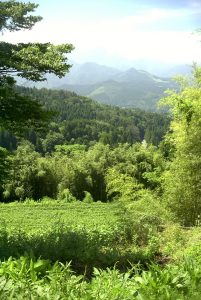
Magome, Gifu. Picture by Rei at en.wikipedia
The vast forests of Gifu Prefecture
Gifu is the second most forested prefecture in Japan, with 80% of the area being forest land. There are many sightseeing spots where visitor can experience abundant natural beauty such as Osaka Waterfall and Amou Prefectural Nature Park, with celebrated woodcrafts of the Hida region in northern Gifu since the eighth century. Woodcrafters produce contemporary creations such as furniture and kitchen utensils by using their traditional techniques.
However, the forests have become less and less relevant to the everyday life of residents. With under-maintained forests conspicuous due to the stagnation of the forestry industry which was once thriving but now in decline, and the depopulation of mountain village areas, the number of people who come into contact in their daily lives with the forests is decreasing. With forests being a proud feature of Gifu Prefecture’s heritage, stakeholders have formulated the “Gifu Tree Education 30 Year Vision” to pass on the culture to future generations. The aim of this is to help citizens coexist with trees, and root them in industries and lifestyles nurtured by historic communities, as well as to safeguard the identity of Gifu Prefecture.
As part of this vision, stakeholders in the 30 years plan will provide guidelines to continuously and gradually develop “citizens taking responsibly for forests regardless of age” for nurturing sustainable activity for future generations.
Stakeholders believe that adults also need to experience forest culture, using all five senses by coming into contact with and becoming familiar with local heritage and help citizens to take responsibly for the forest in future, and are using this vision to guide forest environmental education (see ref. 1). In July 2020, the Forest Education Centre “morinos” was opened to promote the Gifu Tree Education 30 Year Vision.
How and why was Forest Education Centre morinos built?
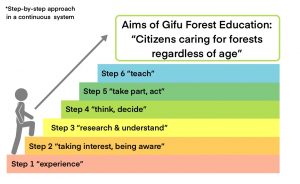 morinos has expanded on the work of the lifelong learning role of the three departments of the Gifu Academy of Forest Science and Culture (specialised education department, specialized engineer training department and lifelong learning department). The centre was built on the grounds of the Academy, next to a training forest which was the ideal place to proceed with “Gifu Tree Education 30 Year Vision” as the backdrop to challenges in managing forest land, part of formulating the vision.
morinos has expanded on the work of the lifelong learning role of the three departments of the Gifu Academy of Forest Science and Culture (specialised education department, specialized engineer training department and lifelong learning department). The centre was built on the grounds of the Academy, next to a training forest which was the ideal place to proceed with “Gifu Tree Education 30 Year Vision” as the backdrop to challenges in managing forest land, part of formulating the vision.
The Academy is based on the philosophy of “coexistence between forests and people,” and provides two years practical education for high school graduates, university graduates, and working adults in order to build a sustainable society in tune with the natural cycle. The Academy is part of the school system and in addition to forestry, students can study subjects related to forests and trees such as environmental education, wooden construction, and woodworking.
Since its opening in 2001, the Academy has also been conducting lifelong learning courses for general citizens of the prefecture. In 2008, mothers of children started a ‘Forest Kindergarten’, and an adventure playground (Note 1) was introduced using a concept from Denmark and created on campus to sustain a connection to the forest for many citizens of the prefecture, in this case including children. When designing a concept to convey the value of forests to as many people as possible, an educational cooperation agreement between the Academy and The University of Applied Forest Sciences Rottenburg in Germany was also established, part of which included faculty members of the Academy visiting Haus des Waldes (Forest House) in Baden-Württemberg, Germany, which was the original inspiration for the construction of morinos in Gifu Prefecture.
The management team of morinos has a total of six people, including four prefecture staff, one faculty member from the forest environment education department, and one forest general education professional. Some of the programme implementation is also outsourced to local agencies.
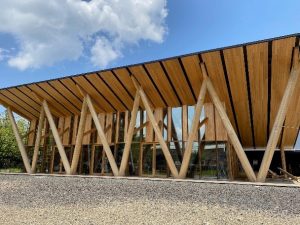
(Left) The building of morinos was based on the design plan of a student studying wooden architecture at the Academy, with the guidance of Kengo Kuma, the renowned Japanese architect, with support and input from the academy teachers. The V-shaped pillars on the front of the building when combined symbolise “W” for “Wald”, meaning forest in German.
What users experience at morinos
There are many ways to spend time at morinos. Visitors can read books in wood scented buildings, rent various facilities and tools to enjoy the forest, from hammocks to binoculars, and enjoy the forest the way they want, or have bonfires in a safe area within the play park. Various tools are available for voluntary work such as chopping and practicing techniques using wood scraps.
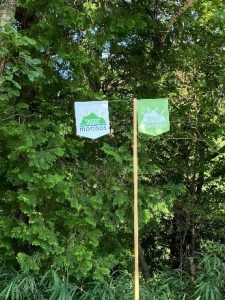
(Right) A flag with the morinos logo marks the entrance.
Visitors can also participate in programmes with a wide range of experiments, from various perspectives such as nature observation, art, sports, and forestry, to learning fun “Do-It-Yourself” though making a bread kiln or making your own hammock. The hope is this will foster connections between participants and place, creativity and independence, and leads to community building. In addition, the programme progresses at the participant’s pace so that the experience is personal to the participant.
morinos develops new activities on themes of ‘connecting people to the forest’ at the same time valuing ‘ongoing change,’ in a programme experiment site created with participants. morinos is not just for the general public but also for leaders and companies. There is also a programme training nursery school teachers on forest knowledge, outdoor skills and risk management so that they can use the forest with infants, and corporate staff also have similar programmes of training utilizing the forest space… Both are made to order with bespoke plans created.
Another aspect of morinos takes advantage of the cooperation agreements with overseas organisations to learn from each other about forest environment education in Europe and other countries and incorporating learning from overseas into programmes. One programme teaches Japanese, Maths, Science, and English in the forest, devised by morinos and starting in earnest in 2018 the programme was rolled out in collaboration with Swedish nature school, which was developing similar new programmes at the same time, after test trials in 2012.
morinos and the future
The role of morinos is to “connect people and the forest.” For that purpose, the centre is mainly engaged in three activities. The first is to develop and implement a wide variety of programmes with a number of ways of accessing those who do not normally enter can get into the forest in a place where they can connect with various people. For that purpose, the philosophy of “enjoying the forest” learned from Germany is more important than the traditional “teaching of the forest” style. The second is to develop the program in educational settings such as nurseries primary schools, elementary and junior high schools. In the field of education, not only “experience in the forest” but also “teaching each subject in the forest” educational methods will become important in the future. The third is to train leaders who connect forests and people. The “culture coexisting with trees” part of the identity of Gifu Prefecture, aims to produce more and more leaders connecting with the next generation throughout the prefecture and throughout the country. That philosophy is also expressed in the facility’s name, the idea is that the leaders will grow together and eventually become a base for taking off, a “nest (in Japanese s[u]) in the forest (mori)”.
In recent years, record heavy rains and typhoons have flooded rivers in Japan, causing great damage, one after another. Crises such as abnormal weather and wildfires are increasing worldwide. Global environmental issues are not the only problems communities are facing, but from the perspective of sustainability in order to tackle such major issues, forests provide resources such as clean air and water, and forests are a part of our lives. The first step is to “know” how we are all connected to the forests and each other; this is the benefit of connecting people through morinos.
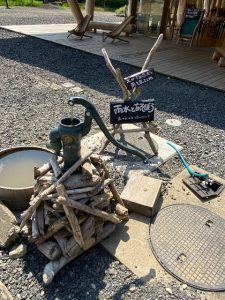 (Left) Rainwater collected on the roof can be stored underground and pumped up, but since only the accumulated amount can be used, the created mechanism supports learning about water as a limited natural resource.
(Left) Rainwater collected on the roof can be stored underground and pumped up, but since only the accumulated amount can be used, the created mechanism supports learning about water as a limited natural resource.
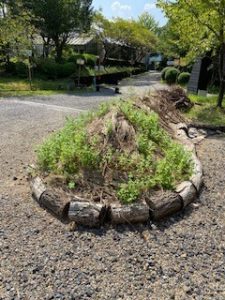
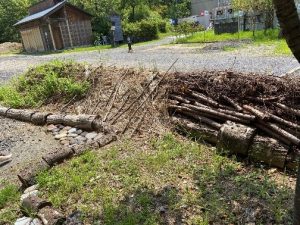
(Center, right) Herbs are grown by mixing the wood originally discarded, the soil from the construction of morinos, with compost, referencing sustainable cultivation methods learnt from Germany.
Note: Play park
‘Play Park’ is a concept that started with the motto, “ better a broken bone, than a broken spirit ” The playground looks chaotic at first glance is designed to help children use their imagination, curiosity and confidence in taking on a challenge.
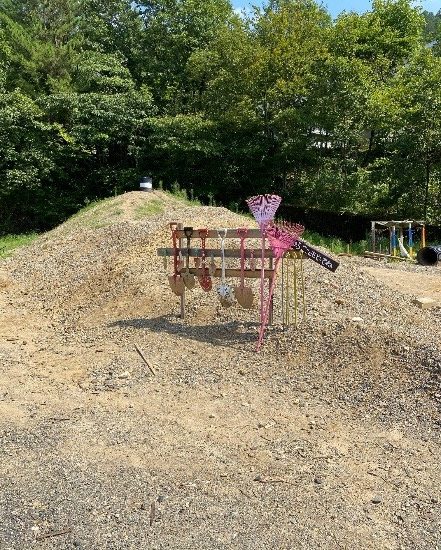 Play park
Play park
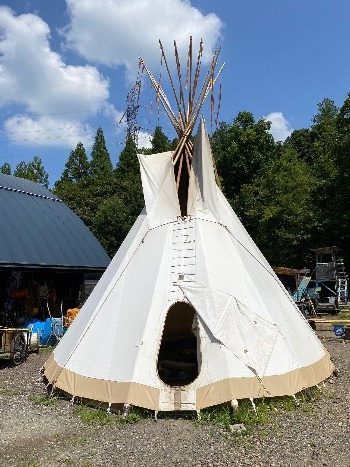
Teepee tent with a firepit
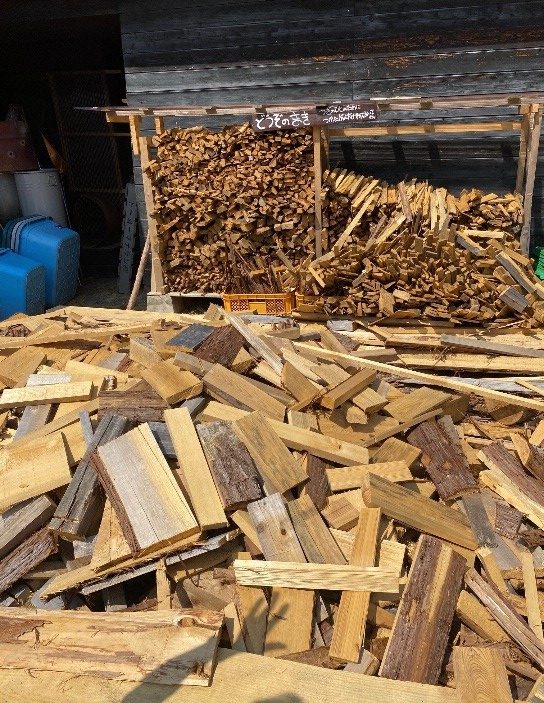
Timber for use in crafts and woodworking
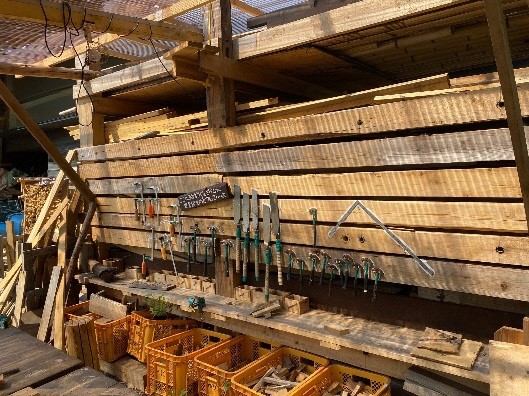
Tools such as saws and hammers for use by visitors
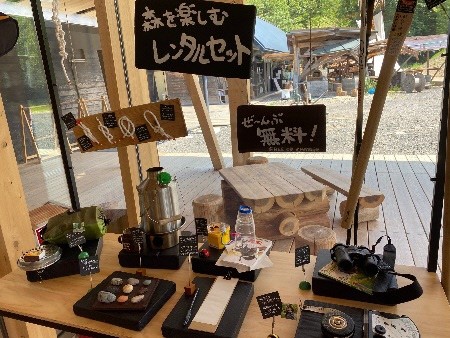
Activity sets for use by visitors such as hammocks, kettles, insect nets, binoculars for bird watching etc.

